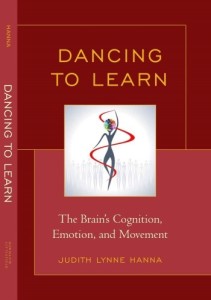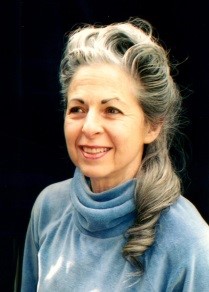What Educators and Parents Should Know About Neuroplasticity, Learning and Dance

— The Dance for Athletes class at Glen Burnie High School performs a swing piece
Dance. Is it merely art? Is it just recreation? Think again.
Dance is now being studied as a pathway to enhance learning. And, scientists say, educators and parents should take note of the movement.
Recently at the annual meeting of the Society for Neuroscience annual meeting, more than 6,800 attendees paid rapt attention to renowned choreographer Mark Morris as he answered questions about the relationship between creativity and dance.
Scientists are turning to dance because it is a multifaceted activity that can help them—and ultimately educators and even parents– demystify how the brain coordinates the body to perform complex, precise movements that express emotion and convey meaning. Dancers possess an extraordinary skill set—coordination of limbs, posture, balance, gesture, facial expression, perception, and action in sequences that create meaning in time and space. Dancers deal with the relationship between experience and observation.
The brain hides from our sight the wondrously complex operations that underlie this feat. Although there are many secrets to unravel about the power of the brain and dance, advances in technology– such as brain scanning techniques and the experiments of dancers, dance makers, and dance viewers– reveal to us the unexpected. Research shows that dance activity registers in regions of the brain responsible for cognition.
More than 400 studies related to interdisciplinary neuroscience reveal the hidden value of dance. For instance, we acquire knowledge and develop cognitively because dance bulks up the brain. Consequently, the brain that “dances” is changed by it. As neuroscientist Antonio Damasio points out, “Learning and creating memory are simply the process of chiseling, modeling, shaping, doing, and redoing our individual brain wiring diagrams.”
Dance is a language of physical exercise that sparks new brain cells (neurogenesis) and their connections. These connections are responsible for acquiring knowledge and thinking. Dancing stimulates the release of the brain-derived protein neurotropic factor that promotes the growth, maintenance, and plasticity of neurons necessary for learning and memory. Plus, dancing makes some neurons nimble so that they readily wire into the neural network. Neural plasticity is the brain’s remarkable ability to change throughout life. (As a septuagenarian, I’m dancing–flamenco, belly dance, jazz, and salsa!) As a method of conveying ideas and emotions with or without recourse to sound, the language of dance draws upon similar places and thought processes in the brain as verbal language. Dance feeds the brain in various kinds of communication.
Through dance, students can learn about academics—and themselves–including sexual, gender, ethnic, regional, national, and career identities. Moreover, dance is a means to help us improve mood and cope with stress that can motivate or interfere with concentration and learning. Influenced by body senses, environment, and culture, the brain “choreographs” dance and more.
Fodder for the Brain
The brain is comprised of about 100 billion electrically active neurons (cells), each connected to tens of thousands of its neighbors at perhaps 100 trillion synapses (the spaces between neurons where information transfers can occur). These atoms of thought relay information through voltage spikes that convert into chemical signals to bridge the gap to other neurons.
All thought, movement, and sensation emanate from electrical impulses coursing through the brain’s interconnected neurons. When they fire together they connect and reconnect, and the connections between them grow stronger in impacting our perception, our comprehension, and different kinds of memory.
If a pattern is repeated, the associated group of neurons fire together resulting in a new memory, its consolidation, and ease of retrieving it. Neurons can improve intellect, memory, and certain kinds of learning if they join the existing neural networks instead of rattling aimlessly around in the brain for a while before dying.
Brain research has given us many insights for dance and other kinds of knowledge. Illustratively, we can apply what psycholinguists have found about learning a second or third verbal language to learning more than one nonverbal language—that is, another dance vocabulary (gesture and locomotion) and grammar (ways movements are put together), and meaning. Children who grow up multilingual have greater brain plasticity, and they multitask more easily. Learning a second or third language uses parts of the brain that knowing only one’s mother tongue doesn’t. Students who learn more than one dance language not only are giving their brains and bodies a workout; they are also increasing their resources for creative dance-making.
Connection for Education
So, what is the relevance of dance for educators and for parents? First, if one of the goals of education is to enhance procedural learning, then dance certainly helps. In traditional (blocked) approaches, the learner is encouraged to focus on mastering a particular dance movement before moving on to new problems. By comparison, varied practice (interleaving) that includes frequent changes of task so that the performer is constantly confronting novel components of the to-be-learned information is more effective.
Second, dance can be offered in multiple venues to promote cognitive growth, including arts magnet schools and academies, regular secondary schools, universities, and community and recreation centers. Venues may have their own dance faculty. Performing arts organizations, nonprofit operations, and dance companies offer dance education, often as partners with academic schools. Illustrative dance programs, some established in the last century but continuing to develop, show how dance education promotes skills for academe, citizenship, and the workplace. Principals can reach out to those offering dance classes and establish invaluable partnerships.
 Obviously curricula and assessment vary in school settings. Dance may be a distinct performing art discipline with in-depth sequential exploration of a coherent body of knowledge guided by highly qualified dance teachers. Or dance may also be a liberal art, complimentary to or part of another subject. Brief introductions to dance may fill gaps in school curricula. Historical serendipity, leadership, teacher interest, parent involvement, and economic resources affect how youngsters experience dance.
Obviously curricula and assessment vary in school settings. Dance may be a distinct performing art discipline with in-depth sequential exploration of a coherent body of knowledge guided by highly qualified dance teachers. Or dance may also be a liberal art, complimentary to or part of another subject. Brief introductions to dance may fill gaps in school curricula. Historical serendipity, leadership, teacher interest, parent involvement, and economic resources affect how youngsters experience dance.
Society privileges mental capacity—mind over matter and emotion. Talking, writing, and numbers are the media of knowledge. However, we now know that dance is a language, brain-driven art, and also, a fuel for learning subjects other than dance. In short, dance is an avenue to thinking, translating, interpreting, communicating, feeling, and creating. As a multimedia communication that generates new brain cells and their connections, dance at any age enriches our cognitive, emotional, and physical development beyond the exercise itself and extends to most facets of life.
—————————
 Judith Lynne Hanna, PhD, is author of Dancing to Learn: The Brain’s Cognition, Emotion, and Movement and a former California-certified social studies and English teacher who has taught dance.
Judith Lynne Hanna, PhD, is author of Dancing to Learn: The Brain’s Cognition, Emotion, and Movement and a former California-certified social studies and English teacher who has taught dance.
Update: Based on the great feedback and comments received below, Judith adds this:
“I welcome collegiate exchanges. I am very aware of the neglect of dance in pre-school, school, and elsewhere. See my article, “Marian Chace Foundation Annual Lecture: October 2005. The Power of Dance Discourse: Explanation in Self-Defense,” American Journal of Dance Therapy 28(1):3–20, 2006. I will email a copy upon request.”
Related articles:



I welcome collegiate exchanges. I am very aware of the neglect of dance in pre-school, school, and elsewhere. See my article, “Marian Chace Foundation Annual Lecture: October 2005. The Power of Dance Discourse: Explanation in Self-Defense,” American Journal of Dance Therapy 28(1):3–20, 2006. I will email a copy upon request.
Yes dance is also a form of mental health regevnative. Hindu God Shiva
Is supreme dancer and NATARAJA TANDAVAM is an epitome of dance forms known to humanity since the age of knowledge. This form of dance clearly raises ones self control of materialistic approach and understanding of emotions and more.